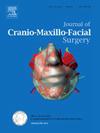Calcium phosphate vs. autologous cranioplasty in a pediatric population
IF 2.1
2区 医学
Q2 DENTISTRY, ORAL SURGERY & MEDICINE
引用次数: 0
Abstract
Background and objective
Persistent skull defects due to trauma, tumors, or neurosurgical procedures often necessitate cranioplasty. Autologous bone flaps are the gold standard but have a high risk of complications in pediatric cases, especially bone flap resorption. This study evaluated alloplastic HA-βTCP (TricOs™) versus autologous cranioplasties, aiming to identify the ideal material for pediatric cranioplasties.
Materials and methods
A retrospective analysis of cranioplasties in pediatric patients with large cranial defects operated between 1995 and 2021 was conducted. Survival times of autologous and alloplastic HA-βTCP (TricOs™) cranioplasties were compared using Kaplan-Meier curves and log-rank test.
Results
The cohort included 22 cranioplasties (11 autologous, 11 alloplastic HA-βTCP (TricOs™)). Autologous cranioplasties demonstrated 63,6 % failure rate versus 9,1 % in the alloplastic group. Mean survival time was significantly longer for alloplastic - (67.61 ± 7.96 months (95 % CI [52.00; 83.21])) compared to autologous cranioplasties (32.75 ± 13.20 months (95 % CI [6.88; 58.61])) (p = 0.035).
Conclusion
Alloplastic HA-βTCP (TricOs™) demonstrated a significantly longer survival time compared to autologous cranioplasties. The findings suggest that HA-βTCP (TricOs™) offers a superior alternative in reducing risk of implant failure, potentially addressing the challenges of bone flap resorption in a pediatric population. Additional studies are warranted to endorse these retrospective findings.
磷酸钙与自体颅骨成形术在儿科人群中的应用。
背景与目的:由于创伤、肿瘤或神经外科手术导致的颅骨缺损通常需要颅骨成形术。自体骨瓣是金标准,但在儿童病例中有很高的并发症风险,特别是骨瓣吸收。本研究评估同种异体HA-βTCP (TricOs™)与自体颅骨成形术,旨在确定儿童颅骨成形术的理想材料。材料与方法:回顾性分析1995年至2021年收治的小儿大颅骨缺损颅骨成形术患者。采用Kaplan-Meier曲线和log-rank检验比较自体和同种异体HA-βTCP (TricOs™)颅骨成形术的生存时间。结果:该队列包括22例颅骨成形术(11例自体,11例异体HA-βTCP (TricOs™))。自体颅骨成形术的失败率为63.6%,而同种异体成形术的失败率为9.1%。同种异体移植组的平均生存时间明显延长,为(67.61±7.96个月)(95% CI [52.00;83.21]))与自体颅骨成形术(32.75±13.20个月)相比(95% CI [6.88;58.61])) (p = 0.035)。结论:与自体颅骨成形术相比,同种异体HA-βTCP (TricOs™)的存活时间明显更长。研究结果表明,HA-βTCP (TricOs™)在降低种植体失败风险方面提供了一种优越的替代方案,可能解决儿科人群骨皮瓣吸收的挑战。有必要进行更多的研究来支持这些回顾性发现。
本文章由计算机程序翻译,如有差异,请以英文原文为准。
求助全文
约1分钟内获得全文
求助全文
来源期刊
CiteScore
5.20
自引率
22.60%
发文量
117
审稿时长
70 days
期刊介绍:
The Journal of Cranio-Maxillofacial Surgery publishes articles covering all aspects of surgery of the head, face and jaw. Specific topics covered recently have included:
• Distraction osteogenesis
• Synthetic bone substitutes
• Fibroblast growth factors
• Fetal wound healing
• Skull base surgery
• Computer-assisted surgery
• Vascularized bone grafts

 求助内容:
求助内容: 应助结果提醒方式:
应助结果提醒方式:


